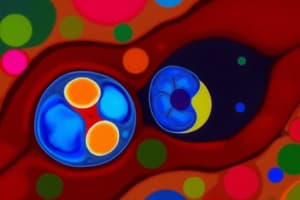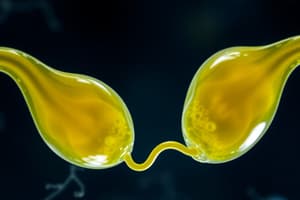Podcast
Questions and Answers
During the process of spermatogenesis, what is the primary purpose of the reductional division (Meiosis I)?
During the process of spermatogenesis, what is the primary purpose of the reductional division (Meiosis I)?
- Separating sister chromatids.
- Separating homologous chromosomes. (correct)
- Ensuring each daughter cell receives an identical copy of each chromosome.
- Condensing and packaging the genetic material into the sperm head.
What is the main function of the acrosome formed during spermiogenesis?
What is the main function of the acrosome formed during spermiogenesis?
- Facilitating the condensation of the sperm nucleus.
- Helping the sperm penetrate the egg. (correct)
- Eliminating excess cytoplasm from the sperm.
- Providing energy for sperm motility.
Which of the following best describes the role of Sertoli cells in spermatogenesis?
Which of the following best describes the role of Sertoli cells in spermatogenesis?
- Transporting sperm from the seminiferous tubules to the epididymis.
- Producing testosterone to promote sperm development.
- Providing structural support, nutrition, and protection to developing sperm cells. (correct)
- Directly producing sperm cells through meiosis.
What is the approximate total time from the initiation of spermatogenesis until the formation of mature spermatozoa?
What is the approximate total time from the initiation of spermatogenesis until the formation of mature spermatozoa?
Which structure is responsible for the initial transport of sperm out of the seminiferous tubules?
Which structure is responsible for the initial transport of sperm out of the seminiferous tubules?
What is the key event during the final stage of spermatogenesis (spermiogenesis)?
What is the key event during the final stage of spermatogenesis (spermiogenesis)?
What is the role of the blood-testis barrier during spermatogenesis?
What is the role of the blood-testis barrier during spermatogenesis?
What is the primary function of Leydig cells within the testis?
What is the primary function of Leydig cells within the testis?
Flashcards
Spermatogenesis
Spermatogenesis
The production of sperm cells, initiated during embryonic development but inactive until puberty.
Chromatic Reduction
Chromatic Reduction
The reduction of chromosome number during spermatogenesis, resulting in haploid spermatozoa.
Reductional Division (Meiosis I)
Reductional Division (Meiosis I)
The first division of meiosis, where homologous chromosomes separate.
Equational Division (Meiosis II)
Equational Division (Meiosis II)
Signup and view all the flashcards
Final Stage of Spermatogenesis
Final Stage of Spermatogenesis
Signup and view all the flashcards
Spermiogenesis
Spermiogenesis
Signup and view all the flashcards
Sertoli Cells
Sertoli Cells
Signup and view all the flashcards
Leydig Cells
Leydig Cells
Signup and view all the flashcards
Study Notes
Gametogenesis
- Spermatogenesis begins during the sixth week of embryonic development, but remains inactive until puberty
- Spermatogenesis is the process of forming sperm cells and it takes approximately 74 days
- The goal of spermatogenesis is to reduce the number of chromosomes and produce haploid spermatozoa
Spermatogenesis
- Chromatic Reduction: Condensation and packaging of genetic material for sperm head
- Reductional Division (Meiosis I): Homologous chromosomes separate, halving the chromosome number
- Equational Division (Meiosis II): Ensures each daughter cell receives a single copy of each chromosome
- Final stage (Spermiogenesis): 24 days; transforms spermatids into mature spermatozoa. DNA is densely packed for efficient transport
- Key Changes: Nucleus condensation, acrosome development, flagellum formation, and removal of cytoplasmic fragments. Mitochondria gather in the midpiece for motility.
Sperm Structure
- Head: Nucleus and acrosome which contains enzymes helping to penetrate the egg
- Neck: Connection to the flagellum
- Intermediate Piece: Mitochondria for motility
- Main Piece & Final Piece: Flagellum for movement
Testis Structure
- Layers: Tunica vaginalis (outer layer) and Tunica albuginea (internal layer); protective coverings
- Lobules: Contain seminiferous tubules, the sites where spermatogenesis occurs
- Functional Components: Germ line cells, Sertoli cells, blood vessels, and vas deferens provide support, phagocytosis, and nutrition for sperm cells
- Blood-testis Barrier: Tight junctions that control what can enter the seminiferous tubules and transport fluid
- Sertoli Cells: Support, phagocytosis, and nutrition for sperm; secrete androgen-binding protein and transport fluid
- Leydig Cells: Produce testosterone to promote spermatogenesis and secondary sexual characteristics. They also promote function of glands like prostate and seminal vesicles, and influence male behavior
Pathway of Sperm Transport
- Seminiferous tubules → Straight tubules → Rete testis → Efferent ductules → Epididymis → Vas deferens → Urethra
Studying That Suits You
Use AI to generate personalized quizzes and flashcards to suit your learning preferences.




